Antibacterial and Cytotoxic Potential of Latex-Mediated Silver Nanoparticles Using Tabernaemontana ventricosa
Abstract
:1. Introduction
2. Materials and Methods
2.1. Latex Collection and Preparation
2.2. Synthesis of AgNPs
2.3. UV-Visible Spectral Analysis
2.4. Preparation, Purification, and Quantification of Samples
2.5. Characterization of AgNPs
2.5.1. Scanning Electron Microscopy (SEM) and Energy-Dispersive X-ray (EDX) Analysis
2.5.2. High-Resolution Transmission Electron Microscopy (HRTEM) analysis
2.5.3. Fourier Transform Infrared (FTIR) Spectral Analysis
2.5.4. Nanoparticle Tracking Analysis (NTA)
2.6. Biological Assessment of Synthesized AgNPs
Sample Preparation
2.7. Antibacterial Screening
2.8. MTT Cytotoxicity Assay
2.9. Statistical Analyses
3. Results and Discussion
3.1. Visual Inspection, UV-Visible Spectroscopy, and Quantification of Synthesized AgNPs
3.2. Scanning Electron Microscopy (SEM) and Energy-Dispersive X-ray (EDX) Analysis
3.3. High-Resolution Transmission Electron Microscopy (HRTEM)
3.4. Nanoparticle Tracking Analysis (NTA) and Zeta Potential
3.5. Fourier Transform Infrared (FTIR) Spectroscopy
3.6. Antibacterial Assay
3.7. Cytotoxicity Assay
4. Conclusions
Author Contributions
Funding
Institutional Review Board Statement
Informed Consent Statement
Data Availability Statement
Acknowledgments
Conflicts of Interest
References
- Mittal, A.K.; Chisti, Y.; Banerjee, U.C. Synthesis of metallic nanoparticles using plant extracts. Biotechnol. Adv. 2013, 31, 346–356. [Google Scholar] [CrossRef] [PubMed]
- Yusuf, M. Silver Nanoparticles: Synthesis and Applications; Springer Nature: Cham, Switzerland, 2020. [Google Scholar]
- Bar, H.; Bhui, D.K.R.; Sahoo, G.P.; Sarkar, P.; De, P.S.; Misra, A. Green synthesis of silver nanoparticles using latex of Jatropha curcas. Colloids Surface. Physicochem. Eng. Asp. 2009, 339, 134–139. [Google Scholar] [CrossRef]
- de Matos, R.A.; da Silva Cordeiro, T.; Samad, R.E.; Vieira Jr, N.D.; Courrol, L.C. Green synthesis of stable silver nanoparticles using Euphorbia milii latex. Colloids Surf. Physicochem. Eng. Asp. 2011, 389, 134–137. [Google Scholar] [CrossRef]
- Chandrasekaran, R.; Gnanasekar, S.; Seetharaman, P.; Keppanan, R.; Arockiaswamy, W.; Sivaperumal, S. Formulation of Carica papaya latex-functionalized silver nanoparticles for its improved antibacterial and anticancer applications. J. Mol. Liq. 2016, 219, 232–238. [Google Scholar] [CrossRef]
- Kalaiselvi, D.; Mohankumar, A.; Shanmugam, G.; Nivitha, S.; Sundararaj, P. Green synthesis of silver nanoparticles using latex extract of Euphorbia tirucalli: A novel approach for the management of root knot nematode, Meloidogyne incognita. Crop Prot. 2019, 117, 108–114. [Google Scholar] [CrossRef]
- Rajkuberan, C.; Prabukumar, S.; Sathishkumar, G.; Wilson, A.; Ravindran, K.; Sivaramakrishnan, S. Facile synthesis of silver nanoparticles using Euphorbia antiquorum L. latex extract and evaluation of their biomedical perspectives as anticancer agents. J. Saudi Chem. Soc. 2017, 21, 911–919. [Google Scholar] [CrossRef]
- Masurkar, S.A.; Chaudhari, P.R.; Shidore, V.B.; Kamble, S.P. Rapid biosynthesis of silver nanoparticles using Cymbopogan citratus (lemongrass) and its antimicrobial activity. Nano-Micro Lett. 2011, 3, 189–194. [Google Scholar] [CrossRef]
- Anbukkarasi, M.; Thomas, P.A.; Sheu, J.R.; Geraldine, P. In vitro antioxidant and anticataractogenic potential of silver nanoparticles biosynthesized using an ethanolic extract of Tabernaemontana divaricata leaves. Biomed. Pharmacother. 2017, 91, 467–475. [Google Scholar] [CrossRef]
- Anbukkarasi, M.; Thomas, P.A.; Teresa, P.A.; Anand, T.; Geraldine, P. Comparison of the efficacy of a Tabernaemontana divaricata extract and of biosynthesized silver nanoparticles in preventing cataract formation in an in-vivo system of selenite-induced cataractogenesis. Biocatal. Agric. Biotechnol. 2020, 23, 101475. [Google Scholar] [CrossRef]
- Manasa, D.J.; Chandrashekar, K.R.; Kumar, P.; Suresh, D.; Madhu Kumar, D.J.; Ravikumar, C.R.; Bhattacharya, T.; Murthy, H.C. Proficient Synthesis of Zinc Oxide Nanoparticles from Tabernaemontana Heyneana Wall. Via Green Combustion Method: Antioxidant, Anti-Inflammatory, Antidiabetic, Anticancer and Photocatalytic Activities. Results Chem. 2021, 3, 100178. [Google Scholar] [CrossRef]
- Salem, W.M.; Haridy, M.; Sayed, W.F.; Hassan, N.H. Antibacterial activity of silver nanoparticles synthesized from latex and leaf extract of Ficus sycomorus. Ind. Crop. Prod. 2014, 62, 228–234. [Google Scholar] [CrossRef]
- Valodkar, M.; Jadeja, R.N.; Thounaojam, M.C.; Devkar, R.V.; Thakore, S. In vitro toxicity study of plant latex-capped silver nanoparticles in human lung carcinoma cells. Mater. Sci. Eng. 2011, 31, 1723–1728. [Google Scholar] [CrossRef]
- Guidelli, E.J.; Ramos, A.P.; Zaniquelli, M.E.D.; Baffa, O. Green synthesis of colloidal silver nanoparticles using natural rubber latex extracted from Hevea brasiliensis. Spectrochim. Acta A Mol. Biomol. Spectrosc. 2011, 82, 140–145. [Google Scholar] [CrossRef] [PubMed]
- Rajkuberan, C.; Sudha, K.; Sathishkumar, G.; Sivaramakrishnan, S. Antibacterial and cytotoxic potential of silver nanoparticles synthesized using latex of Calotropis gigantea L. Spectrochim. Acta A Mol. Biomol. Spectrosc. 2015, 136, 924–930. [Google Scholar] [CrossRef]
- Schmidt, E.; Lotter, M.; McCleland, W. Trees and Shrubs of Mpumalanga and Kruger National Park; Jacana Media: Johannesburg, South Africa, 2002; pp. 566–569. [Google Scholar]
- Schmelzer, G.B.; Gurib-Fakim, A. Plant Resources of Tropical Africa (PROTA). In Medicinal Plants, 1st ed.; Backhuys Publishers: Wageningen, The Netherlands, 2008; Volume 1, pp. 597–598. [Google Scholar]
- Mehrbod, P.; Abdalla, M.A.; Njoya, E.M.; Ahmed, A.S.; Fotouhi, F.; Farahmand, B.; Gado, D.A.; Tabatabaian, M.; Fasanmi, O.G.; Eloff, J.N.; et al. South African medicinal plant extracts active against influenza A virus. BMC Complement. Altern. Med. 2018, 18, 112–121. [Google Scholar] [CrossRef]
- Van Beek, T.; Deelder, A.; Verpoorte, R.; Svendsen, A. Antimicrobial, Antiamoebic and Antiviral Screening of some Tabernaemontana Species. Planta Med. 1984, 50, 180–185. [Google Scholar] [CrossRef]
- Andima, M.; Ndakala, A.; Derese, S.; Biswajyoti, S.; Hussain, A.; Yang, L.J.; Akoth, O.E.; Coghi, P.; Pal, C.; Heydenreich, M.; et al. Antileishmanial and cytotoxic activity of secondary metabolites from Taberneamontana ventricosa and two aloe species. Nat. Prod. Res. 2021, 36, 1365–1369. [Google Scholar] [CrossRef]
- Schripsema, J.; Hermans-Lokkerbol, A.; Van Der Heijden, R.; Verpoorte, R.; Svendsen, A.B.; Van Beek, T.A. Alkaloids of Tabernaemontana ventricosa. J. Nat. Prod. 1986, 49, 733–735. [Google Scholar] [CrossRef]
- Ambu, G.; Chaudhary, R.P.; Mariotti, M.; Cornara, L. Traditional uses of medicinal plants by ethnic people in the Kavrepalanchok district, Central Nepal. Plants 2020, 9, 759. [Google Scholar] [CrossRef]
- Chandra, H.; Kumari, P.; Bontempi, E.; Yadav, S. Medicinal plants: Treasure trove for green synthesis of metallic nanoparticles and their biomedical applications. Biocatal. Agric. Biotechnol. 2020, 24, 101518. [Google Scholar] [CrossRef]
- Clinical and Laboratory Standards Institute (CLSI). Performance Standards for Antimicrobial Disk Susceptibility Tests; Wayne, P.A., Ed.; Clinical and Laboratory Standards Institute (CLSI): Wayne, PA, USA, 2006. [Google Scholar]
- Marathe, N.P.; Rasane, M.H.; Kumar, H.; Patwardhan, A.A.; Shouche, Y.S.; Diwanay, S.S. In vitro antibacterial activity of Tabernaemontana alternifolia (Roxb) stem bark aqueous extracts against clinical isolates of methicillin resistant Staphylococcus aureus. Ann. Clin. Microbiol. Antimicrob. 2013, 12, 26. [Google Scholar] [CrossRef] [PubMed]
- Mosmann, T. Rapid colorimetric assay for cellular growth and survival: Application to proliferation and cytotoxicity assays. J. Immunol. Methods. 1983, 65, 55–63. [Google Scholar] [CrossRef] [PubMed]
- Daniels, A.N.; Singh, M. Sterically stabilized siRNA: Gold nanocomplexes enhance c-MYC silencing in a breast cancer cell model. Nanomedicine 2019, 14, 1387–1401. [Google Scholar] [CrossRef] [PubMed]
- Rathnayake, I.; Ismail, H.; Azahari, B.; De Silva, C.; Darsanasiri, N. Imparting antimicrobial properties to natural rubber latex foam via green synthesized silver nanoparticles. J. Appl. Polym. Sci. 2014, 131, 1–10. [Google Scholar] [CrossRef]
- Kumar, V.; Yadav, S.K. Plant-mediated synthesis of silver and gold nanoparticles and their applications. J. Chem. Technol. Biotechnol. 2009, 84, 151–157. [Google Scholar] [CrossRef]
- Lee, K.X.; Shameli, K.; Yew, Y.P.; Teow, S.Y.; Jahangirian, H.; Rafiee-Moghaddam, R.; Webster, T.J. Recent developments in the facile bio-synthesis of gold nanoparticles (AuNPs) and their biomedical applications. Int. J. Nanomed. 2020, 15, 275. [Google Scholar] [CrossRef]
- Zargar, M.; Hamid, A.A.; Bakar, F.A.; Shamsudin, M.N.; Shameli, K.; Jahanshiri, F.; Farahani, F. Green synthesis and anti-bacterial effect of silver nanoparticles using Vitex negundo L. Molecules 2011, 16, 6667–6676. [Google Scholar] [CrossRef]
- Akula, R.; Ravishankar, G.A. Influence of abiotic stress signals on secondary metabolites in plants. Plant Siganl. Behav. 2011, 6, 1720–1731. [Google Scholar] [CrossRef]
- Sigamoney, M.; Shaik, S.; Govender, P.; Krishna, S.B.N. African leafy vegetables as bio-factories for silver nanoparticles: A case study on Amaranthus dubius C Mart. Ex Thell. S. Afr. J. Bot. 2016, 103, 230–240. [Google Scholar] [CrossRef]
- Hu, S.; Hsieh, Y.L. Silver nanoparticle synthesis using lignin as reducing and capping agents: A kinetic and mechanistic study. Int. J. Biol. Macromol. 2016, 82, 856–862. [Google Scholar] [CrossRef]
- Almeida, L.M.; Magno, L.N.; Pereira, A.C.; Guidelli, É.J.; Baffa Filho, O.; Kinoshita, A.; Goncalves, P.J. Toxicity of silver nanoparticles released by Hancornia speciosa (Mangabeira) Biomembrane. Spectrochim. Acta A Mol. Biomol. Spectrosc. 2019, 210, 329–334. [Google Scholar] [CrossRef] [PubMed]
- Akwu, N.A.; Naidoo, Y.; Singh, M.; Nundkumar, N.; Daniels, A.; Lin, J. Two Temperatures Biogenic Synthesis of Silver Nanoparticles from Grewia lasiocarpa E. Mey. ex Harv. Leaf and Stem Bark Extracts: Characterization and Applications. J. BioNano Sci. 2021, 11, 142–158. [Google Scholar] [CrossRef]
- Sathishkumar, M.; Sneha, K.; Won, S.W.; Cho, C.W.; Kim, S.; Yun, Y.S. Cinnamon zeylanicum bark extract and powder mediated green synthesis of nano-crystalline silver particles and its bactericidal activity. Colloids Surf. B 2009, 73, 332–338. [Google Scholar] [CrossRef] [PubMed]
- Patil, C.D.; Borase, H.P.; Patil, S.V.; Salunkhe, R.B.; Salunke, B.K. Larvicidal activity of silver nanoparticles synthesized using Pergularia daemia plant latex against Aedes aegypti and Anopheles stephensi and nontarget fish Poecillia reticulata. Parasitol. Res. 2012, 111, 555–562. [Google Scholar] [CrossRef] [PubMed]
- Borase, H.P.; Patil, C.D.; Suryawanshi, R.K.; Patil, S.V. Ficus carica latex-mediated synthesis of silver nanoparticles and its application as a chemophotoprotective agent. Appl. Biochem. Biotechnol. 2013, 171, 676–688. [Google Scholar] [CrossRef]
- Song, J.Y.; Jang, H.K.; Kim, B.S. Biological synthesis of gold nanoparticles using Magnolia kobus and Diopyros kaki leaf extracts. Process Biochem. 2009, 44, 1133–1138. [Google Scholar] [CrossRef]
- Yaqoob, A.A.; Umar, K.; Ibrahim, M.N.M. Silver nanoparticles: Various methods of synthesis, size affecting factors and their potential applications–a review. Appl. Nanosci. 2020, 10, 1369–1378. [Google Scholar] [CrossRef]
- Durgawale, P.P.; Phatak, R.S.; Hendre, A.S. Biosynthesis of silver nanoparticles using latex of Syandenium grantii Hook f and its assessment of antibacterial activities. Dig. J. Nanomater. Bios. 2015, 10, 847. [Google Scholar]
- Magudapathy, P.; Gangopadhyay, P.; Panigrahi, B.K.; Nair, K.G.M.; Dhara, S. Electrical transport studies of Ag nanoclusters embedded in glass matrix. Physica B Condens. Matter 2001, 299, 142–146. [Google Scholar] [CrossRef]
- Annadurai, G.; Gnanajobitha, G.; Kannan, C. Green synthesis of silver nanoparticle using Elettaria cardamomom and assessment of its anti-microbial activity. Int. J. Pharm. Sci. 2021, 3, 323–330. [Google Scholar]
- Devaraj, P.; Aarti, C.; Kumari, P. Synthesis and characterization of silver nanoparticles using Tabernaemontana divaricata and its cytotoxic activity against MCF7 cell line. Int. J. Pharmacol. Pharm. Sci. 2014, 6, 86–90. [Google Scholar]
- Bakar, N.A.; Ismail, J.; Bakar, M.A. Synthesis and characterization of silver nanoparticles in natural rubber. Mater. Chem. Phys. 2007, 104, 276–283. [Google Scholar] [CrossRef]
- Raheman, F.; Deshmukh, S.; Ingle, A.; Gade, A.; Rai, M. Silver nanoparticles: Novel antimicrobial agent synthesized from an endophytic fungus Pestalotia sp. isolated from leaves of Syzygium cumini (L). Nano Biomed. Eng. 2011, 3, 174–178. [Google Scholar] [CrossRef]
- Banu, A.; Rathod, V. Synthesis and characterization of silver nanoparticles by Rhizopus stolonier. Int. J. Biomed. Adv. Res. 2011, 2, 148–158. [Google Scholar] [CrossRef]
- Mohamed, N.H.; Ismail, M.A.; Abdel-Mageed, W.M.; Shoreit, A.A.M. Antimicrobial activity of latex silver nanoparticles using Calotropis procera. Asian Pac. J. Trop. Biomed. 2014, 4, 876–883. [Google Scholar] [CrossRef]
- Mohamed, N.H.; Ismail, M.A.; Abdel-Mageed, W.M.; Shoreit, A.A.M. Antimicrobial activity of green silver nanoparticles from endophytic fungi isolated from Calotropis procera (Ait) latex. Microbiology 2019, 165, 967–975. [Google Scholar] [CrossRef] [PubMed]
- Akinyelu, J.; Singh, M. Folate-tagged chitosan functionalized gold nanoparticles for enhanced delivery of 5-fluorouracil to cancer cells. Appl. Nanosci. 2019, 9, 7–17. [Google Scholar] [CrossRef]
- Oladimeji, O.; Akinyelu, J.; Daniels, A.; Singh, M. Modified Gold Nanoparticles for efficient Delivery of Betulinic Acid to Cancer Cell Mitochondria. Int. J. Mol. Sci. 2021, 22, 5072. [Google Scholar] [CrossRef]
- Kumar, V.; Yadav, S.C.; Yadav, S.K. Syzygium cumini leaf and seed extract mediated biosynthesis of silver nanoparticles and their characterization. J. Chem. Technol. Biotechnol. 2010, 85, 1301–1309. [Google Scholar] [CrossRef]
- Fatima, K.; Mahmud, S.; Yasin, H.; Asif, R.; Qadeer, K.; Ahmad, I. Authentication of various commercially available crude drugs using different quality control testing parameters. Pak. J. Pharm. Sci. 2020, 33, 1641–1657. [Google Scholar]
- Preetam Raj, J.P.; Purushothaman, M.; Ameer, K.; Panicker, S.G. In-vitro anticancer and antioxidant activity of gold nanoparticles conjugate with Tabernaemontana divaricata flower SMs against MCF-7 breast cancer cells. Korean Chem. Eng. Res. 2016, 54, 5–80. [Google Scholar] [CrossRef]
- Attri, P.; Garg, S.; Ratan, J.K.; Giri, A.S. Silver Nanoparticles from Tabernaemontana Divaricate leaf extract: Mechanism of action and Bio-application for photo degradation of 4-Aminopyridine. Res. Sq. 2021, 30, 24856–24875. [Google Scholar] [CrossRef] [PubMed]
- Shrivastava, S.; Bera, T.; Roy, A.; Singh, G.; Ramachandrarao, P.; Dash, D. Characterization of enhanced antibacterial effects of novel silver nanoparticles. Nanotechnology 2007, 18, 225103. [Google Scholar] [CrossRef] [PubMed]
- Vivekanandhan, S.; Christensen, L.; Misra, M.; Mohanty, A.K. Biosynthesis of silver nanoparticles using murraya koenigii (curry leaf): An investigation on the effect of broth concentration in reduction mechanism and particle size. Adv. Mater. Lett. 2011, 2, 429–434. [Google Scholar]
- Raja, A.; Ashokkumar, S.; Marthandam, R.P.; Jayachandiran, J.; Khatiwada, C.P.; Kaviyarasu, K.; Raman, R.G.; Swaminathan, M. Eco-friendly preparation of zinc oxide nanoparticles using Tabernaemontana divaricata and its photocatalytic and antimicrobial activity. J. Photochem. Photobiol. Biol. 2018, 181, 53–58. [Google Scholar] [CrossRef]
- Hassan, M.H.; Ismail, M.A.; Moharram, A.M.; Shoreit, A.A. Phytochemical and antimicrobial of latex serum of Calotropis procera and its silver nanoparticles against some reference pathogenic strains. J. Ecol. Health Environ. 2017, 5, 65–75. [Google Scholar] [CrossRef]
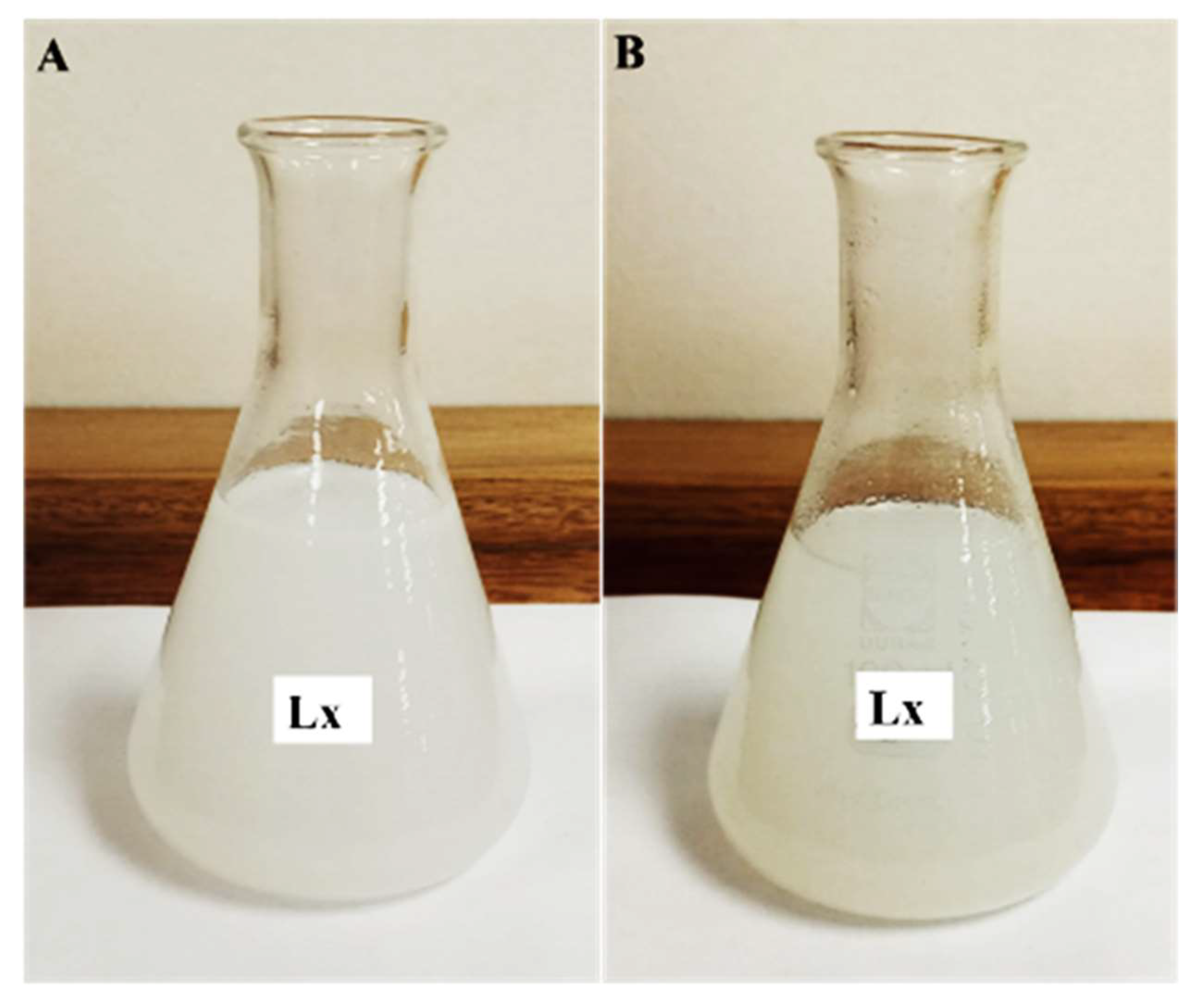
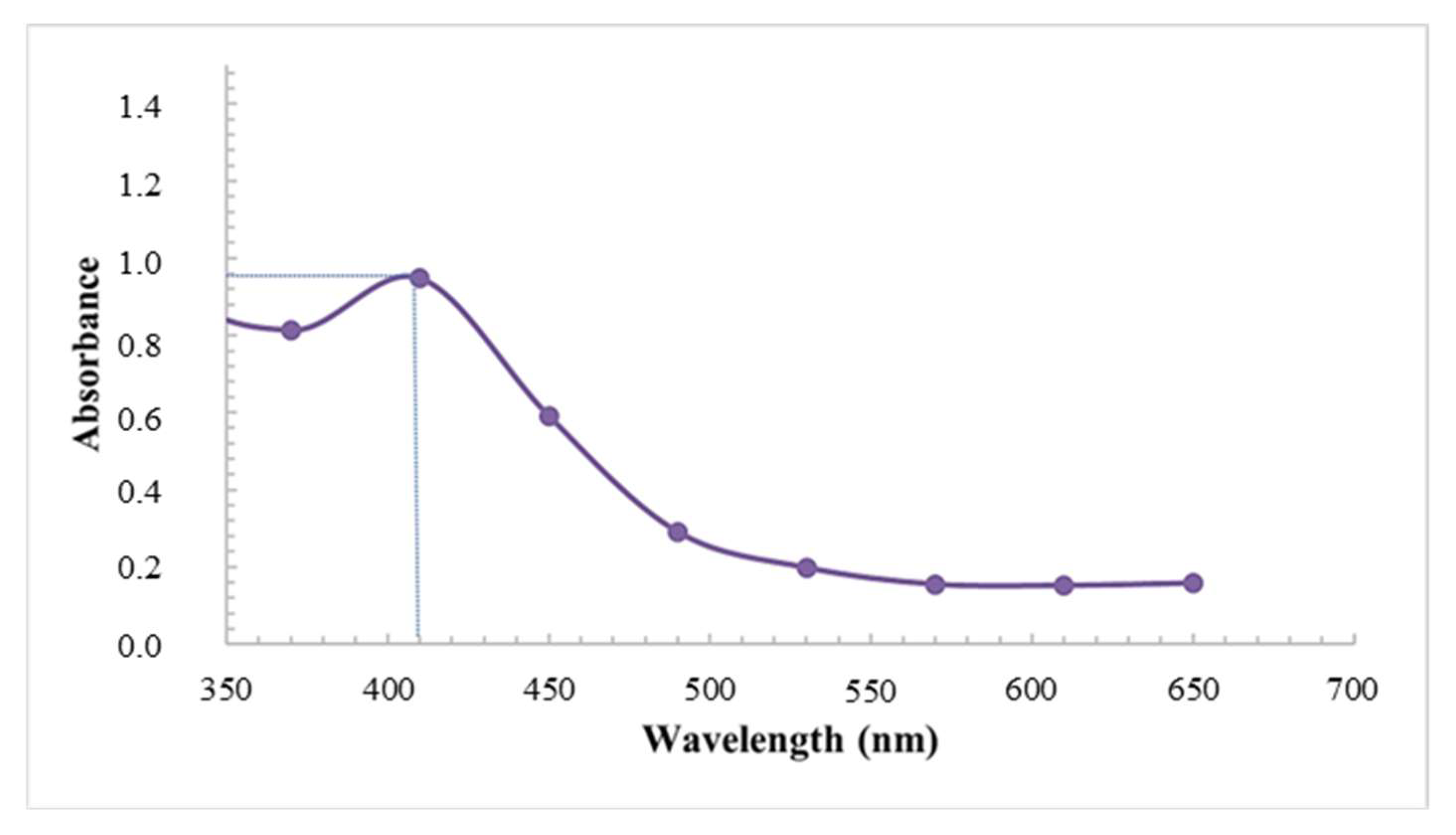
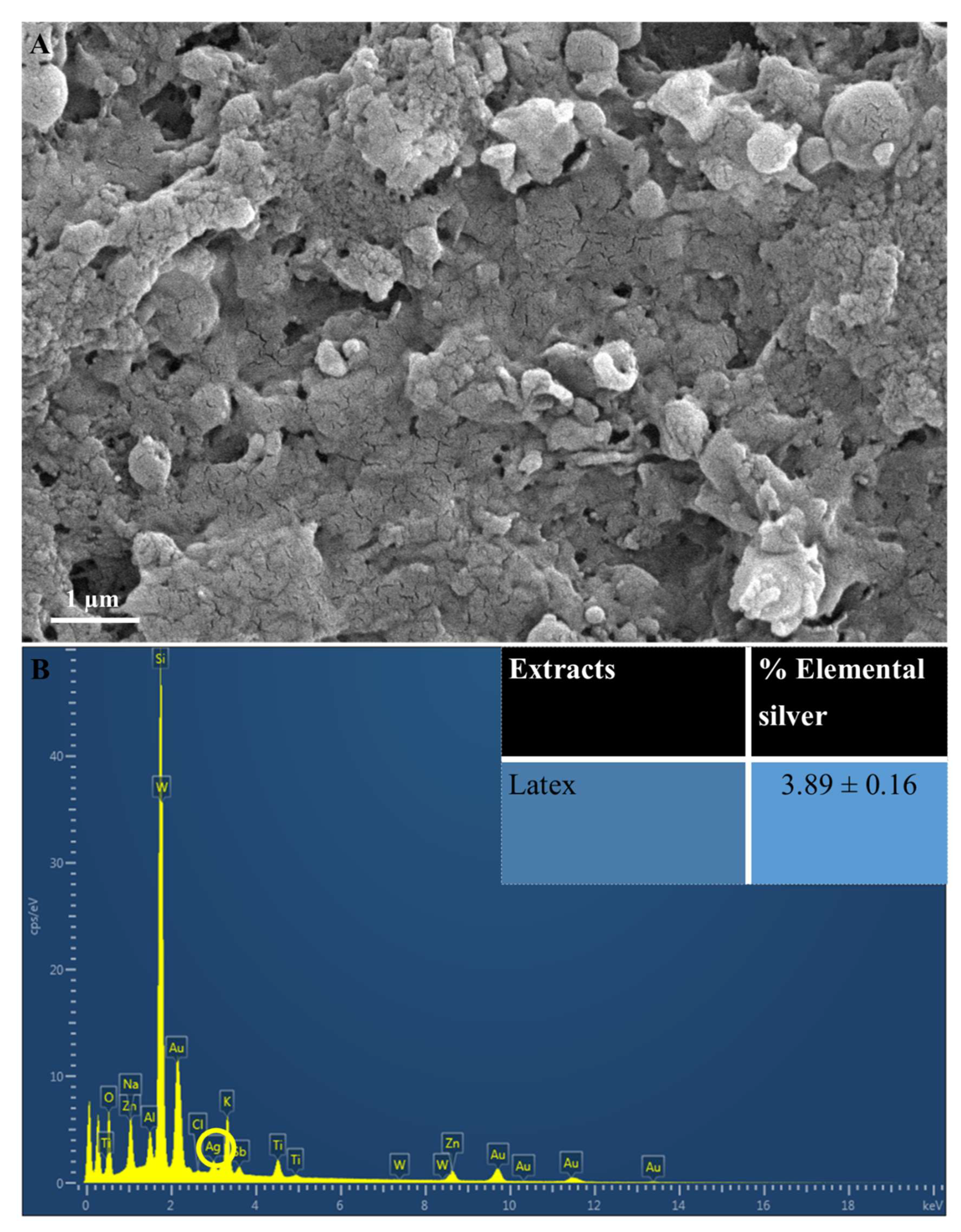
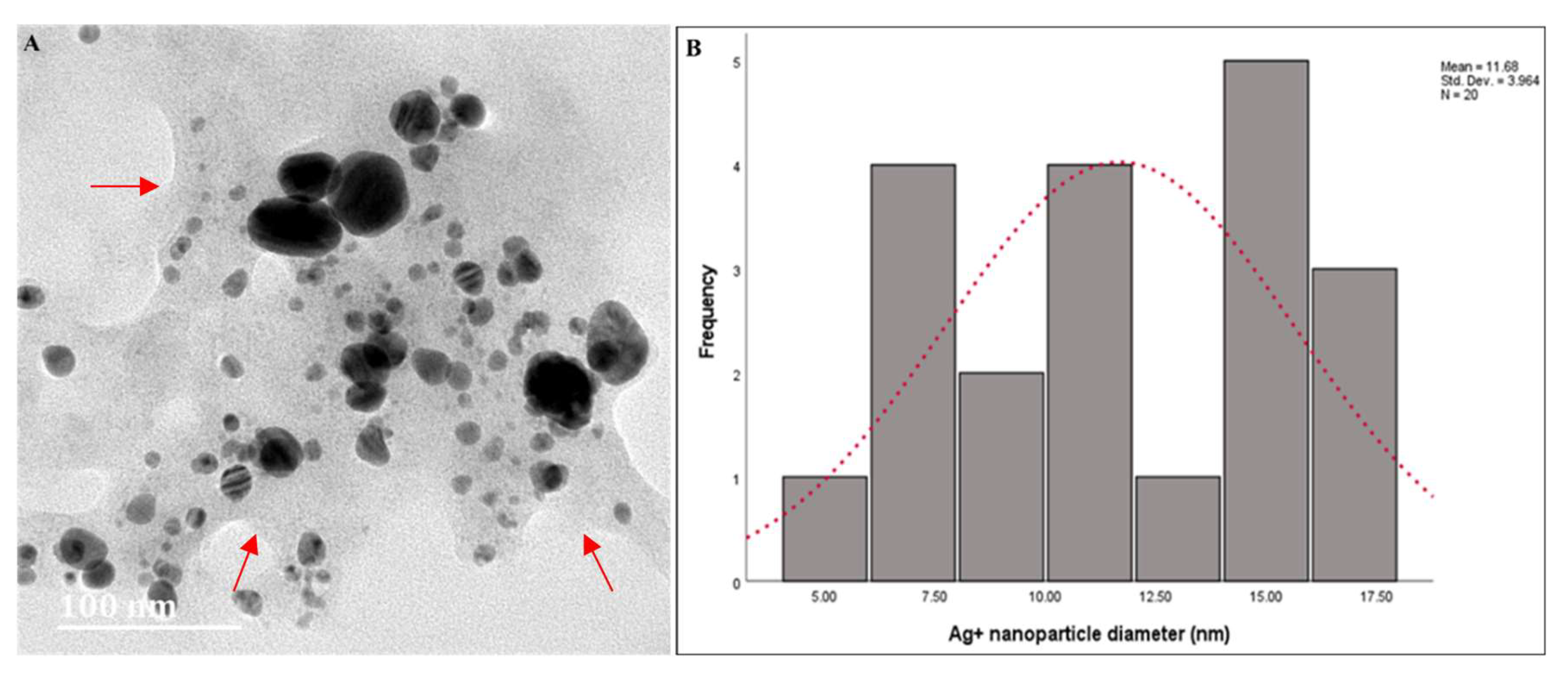
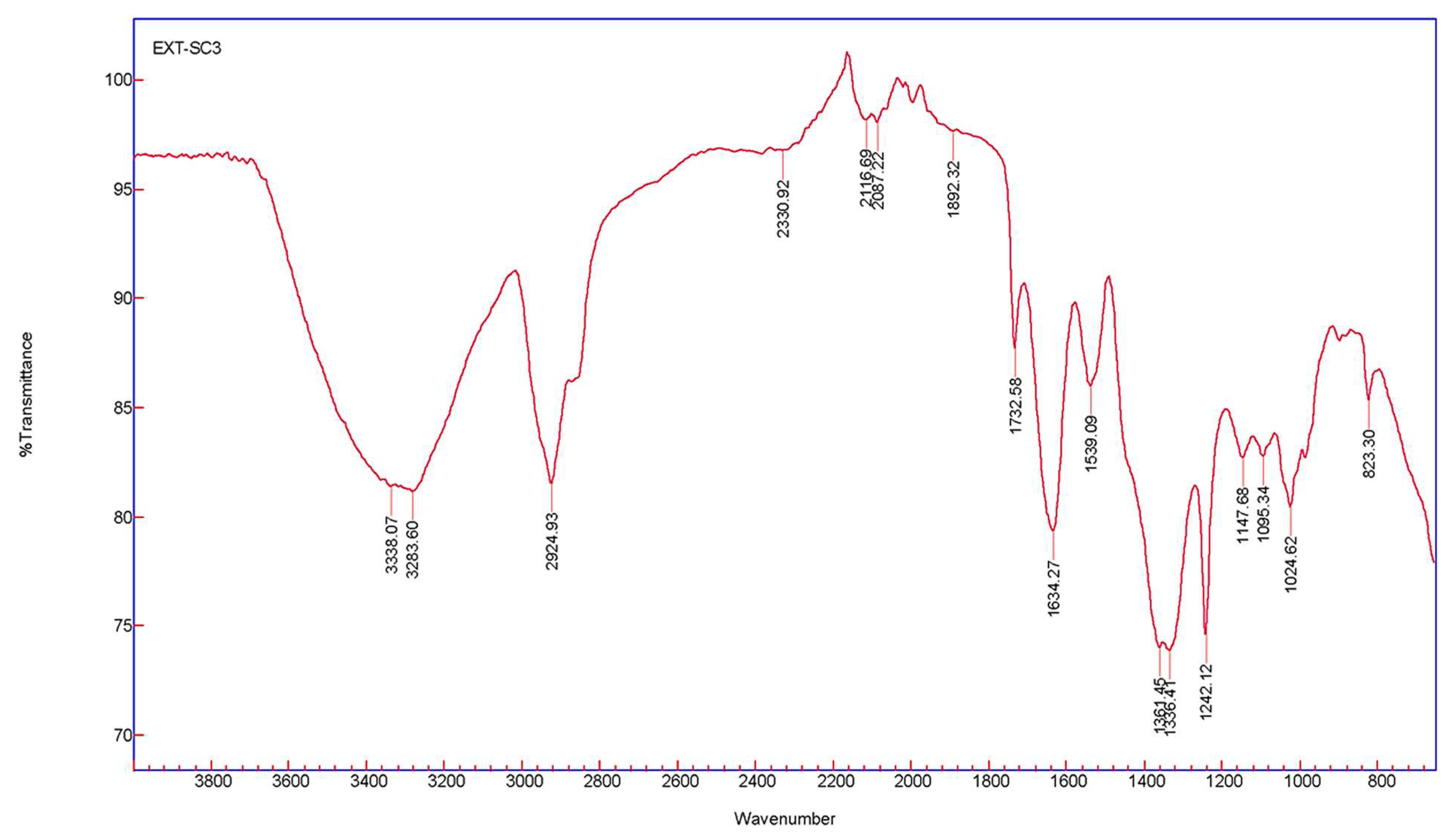
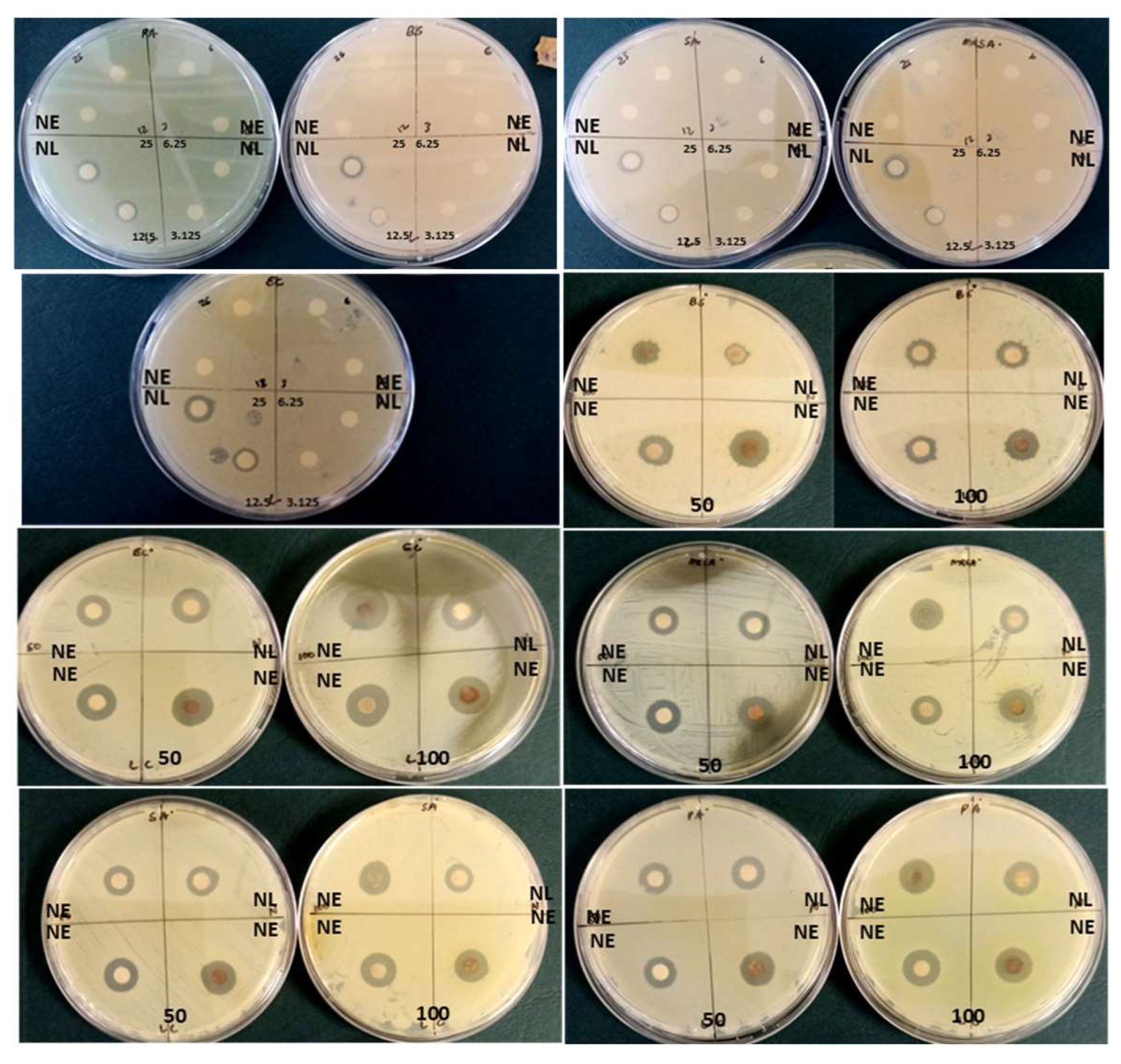
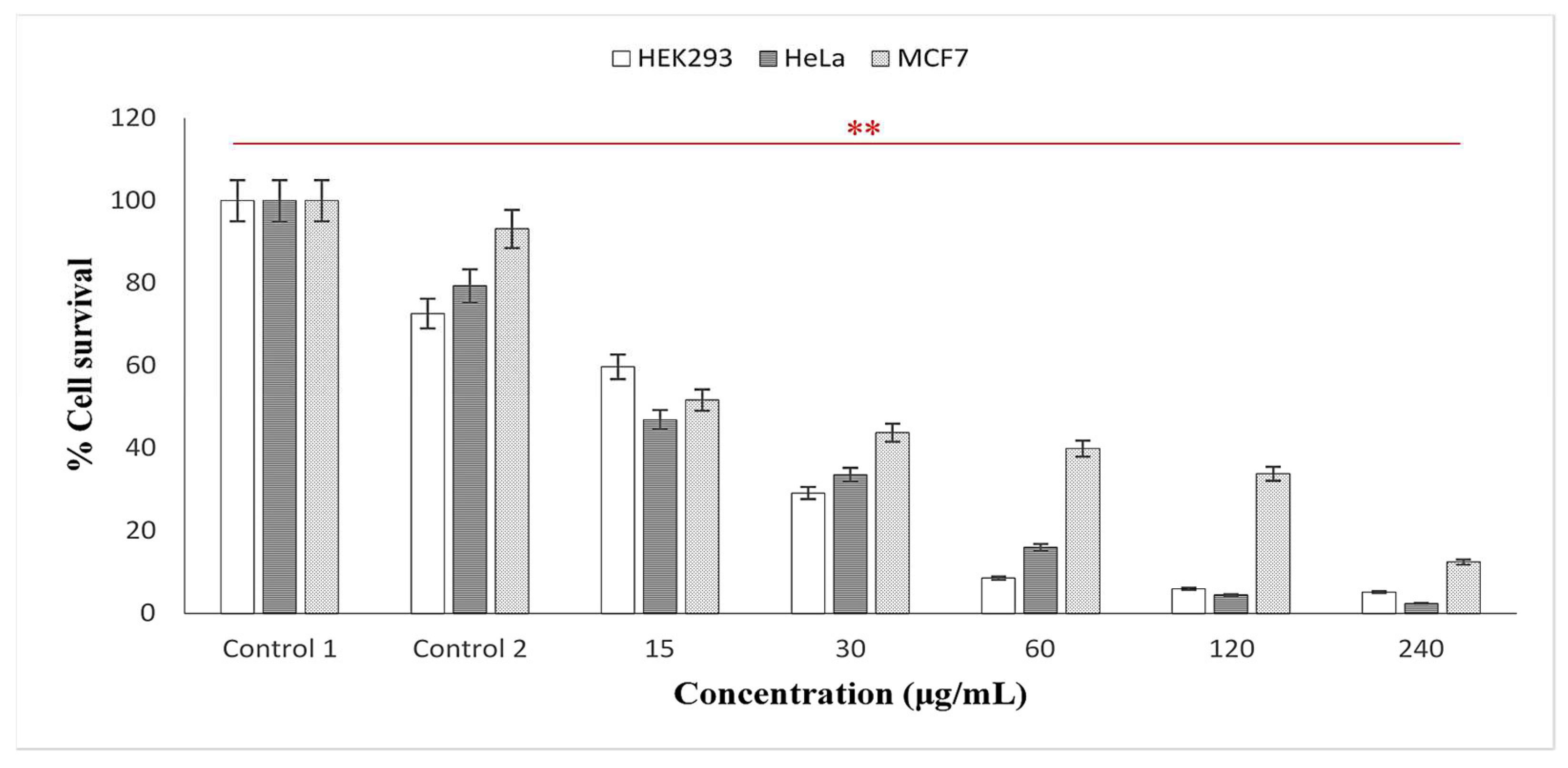
| Extract | Latex |
|---|---|
| Dried extract yield (g) | 0.15 |
| Yield (%) | 14.80 |
| Extracts | Nanoparticle Diameter (nm) | Zeta Potential (mV) |
|---|---|---|
| Fresh latex extract | 57.2 ± 5.7 | 12.3 ± 1.2 |
| Absorption Frequency (cm−1) | Types of Absorption/Vibration | Appearance | Interference/ Functional Group | Compound Class |
|---|---|---|---|---|
| 3338.07 | Stretch | Strong broad | O–H | Alcohol |
| 3283.60 | Stretch | Strong broad | O–H | Alcohol |
| 2924.93 | Stretch | Medium | C–H | Alkane |
| 2330.92 | Stretch | Strong | O=C=O | Carbon dioxide |
| 2116.69 | Stretch | Weak | C≡C | Alkyne |
| 2087.22 | Stretch | Strong | N=C=S | Isothiocyanate |
| 1892.32 | Bending | Weak | C–H | Aromatic compound |
| 1732.58 | Stretch | Strong | C=O | Aldehyde |
| 1634.27 | Bending | Medium | C=C | Alkene |
| 1539.09 | Stretch | Strong | N–O | Nitro compound |
| 1361.45 | Bending | Medium | O–H | Phenol |
| 1336.41 | Stretch | Strong | S=O | Sulfonate |
| 1242.12 | Stretch | Strong | C–O | Alkyl aryl ether |
| 1147.68 | Stretch | Strong | C–O | Tertiary alcohol |
| 1095.34 | Stretch | Strong | C–O | Secondary alcohol |
| 1024.62 | Stretch | Medium | C–N | Amine |
| 823.30 | Bending | Strong | C–H | 1,2,3-trisubstituted |
| Concentration (mg/mL) | Bacterial Strains | |||||
|---|---|---|---|---|---|---|
| BS | EC | MRSA | SA | PA | ||
| Latex AgNPs | 3.125 | 6.33 ± 0.58 | 8.67 ± 0.58 | 9.67 ± 0.58 | 9.00 ± 1.00 | 8.67 ± 1.15 |
| 6.25 | 7.00 ± 0.00 | 9.00 ± 1.00 | 10.33 ± 0.58 | 10.00 ± 1.00 | 9.00 ± 1.00 | |
| 12.5 | 8.67 ± 0.58 | 10.67 ± 1.15 | 10.67 ± 1.15 | 10.33 ± 0.58 | 9.33 ± 1.15 | |
| 25 | 8.67 ± 0.58 | 11.00 ± 0.00 | 11.00 ± 1.00 | 10.67 ± 0.58 | 10.67 ± 0.58 | |
| 50 | 9.33 ± 0.58 | 12.33 ± 0.58 | 11.00 ± 1.00 | 11.33 ± 0.58 | 11.33 ± 0.58 | |
| 100 | 10.33 ± 0.58 | 12.67 ± 1.15 | 11.33 ± 0.58 | 11.67 ± 0.58 | 11.33 ± 1.15 | |
| Positive control (10 µg/mL) | 9.67 ± 1.53 * | 9.67 ± 0.58 | 9.33 ± 1.53 * | 10.67 ± 1.15 * | 9.00 ± 1.00 | |
| Extract | Cell Lines | ||
|---|---|---|---|
| HEK293 | HeLa | MCF-7 | |
| Concentration µg/mL | |||
| Latex | 13.70 | 10.52 | 20.60 |
Disclaimer/Publisher’s Note: The statements, opinions and data contained in all publications are solely those of the individual author(s) and contributor(s) and not of MDPI and/or the editor(s). MDPI and/or the editor(s) disclaim responsibility for any injury to people or property resulting from any ideas, methods, instructions or products referred to in the content. |
© 2023 by the authors. Licensee MDPI, Basel, Switzerland. This article is an open access article distributed under the terms and conditions of the Creative Commons Attribution (CC BY) license (https://creativecommons.org/licenses/by/4.0/).
Share and Cite
Naidoo, C.M.; Naidoo, Y.; Dewir, Y.H.; Singh, M.; Daniels, A.N.; Lin, J.; Alsughayyir, A. Antibacterial and Cytotoxic Potential of Latex-Mediated Silver Nanoparticles Using Tabernaemontana ventricosa. Appl. Sci. 2023, 13, 11363. https://doi.org/10.3390/app132011363
Naidoo CM, Naidoo Y, Dewir YH, Singh M, Daniels AN, Lin J, Alsughayyir A. Antibacterial and Cytotoxic Potential of Latex-Mediated Silver Nanoparticles Using Tabernaemontana ventricosa. Applied Sciences. 2023; 13(20):11363. https://doi.org/10.3390/app132011363
Chicago/Turabian StyleNaidoo, Clarissa Marcelle, Yougasphree Naidoo, Yaser Hassan Dewir, Moganavelli Singh, Aliscia Nicole Daniels, Johnson Lin, and Ali Alsughayyir. 2023. "Antibacterial and Cytotoxic Potential of Latex-Mediated Silver Nanoparticles Using Tabernaemontana ventricosa" Applied Sciences 13, no. 20: 11363. https://doi.org/10.3390/app132011363
APA StyleNaidoo, C. M., Naidoo, Y., Dewir, Y. H., Singh, M., Daniels, A. N., Lin, J., & Alsughayyir, A. (2023). Antibacterial and Cytotoxic Potential of Latex-Mediated Silver Nanoparticles Using Tabernaemontana ventricosa. Applied Sciences, 13(20), 11363. https://doi.org/10.3390/app132011363









